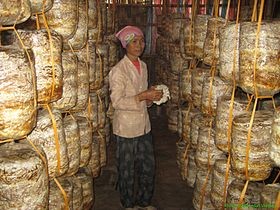(VOV) – One key task of new rural development program in the northern province of Ha Nam is to develop production and increase people’s incomes. Mushroom growing is one of 10 models the province has been implementing to create jobs for the locals.
 |
| Cat’s ear mushrooms are grown in thousands of bags in the house. (Photo: corinasiavietnam.org) |
Visiting Dinh Tri Trung’s house in Kha Phong hamlet, Kim Bang district, we’re impressed by thousands of baskets of cat’s ear mushrooms. Trung said that he has succeeded thanks to financial support of 9.6 dollars per square meter and farming techniques from the provincial authorities. He now earns as much as 192 dollars a month. Trung said ‘in the past, our earnings depended mainly on growing rice, which was just enough for us to eat without any savings. It’s so easy to grow mushrooms that any farmer can do it. Growing mushrooms between crops is a good way for farmers to generate more income. Compared to growing rice, mushroom cultivation is easy. We only have to water them and don’t need any fertilizers. If we don’t grow mushrooms, we have to go to urban areas like Hanoi to work in construction jobs.’
The project to develop the mushroom production is one of 10 programs Ha Nam has been implementing to help local farmers make extra money after harvest time. Chu Van Hop, Vice head of Kha Phong’s Agricultural Cooperative, says the locals can either make the most of their yards or gardens or erect canvas shacks to grow mushrooms. It takes about 480 dollars in initial investment to plant an area of 60 or 70 square meters. Agricultural by-products such as rice straw, sawdust, or rice husks can be used as raw materials for the growing. The first harvest can be made after a month and mushroom prices are quite stable at about 4.8 dollars per kilo of dried cat’s ear mushrooms. In terms of economic efficiency, mushrooms are three or four times as profitable as rice growing. Mr. Hop said: ‘Many people in Kha Phong hamlet registered to participate in growing mushrooms as soon as the program was launched. We have asked for more training courses this year to teach farmers better techniques. Many households have registered to take part in such courses’
Nguyen Manh Hung, Deputy Director of the provincial Agriculture and Rural Development Department, says the agency has signed a contract with the Ngoc Dong Company to provide techniques, supply materials, and ensure a market for farmers. Last year, the province had 40 households involved in mushroom farming on 36,000 square meters, turning out 136 tons and earning 192,000 dollars. Between now and 2015, the model will be expanded. 200 more households will participate to produce about 380 tons, tripling the 2012 figure. Mr. Hung said: ‘We have developed a road map until 2015 for developing food mushrooms and medicinal mushrooms. The province has designed a specific mechanism in which every 70 square meters will be supported with expenses for variety and training while the product output will be ensured. This year capital sources will be secured for those who participate in the program.’
The model for growing mushrooms in Ha Nam has proven to have many advantages and is likely to become more efficient, offering even less investment, quicker harvest, and higher profits.
Le Thom – Thu Hang - VOV